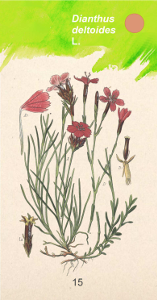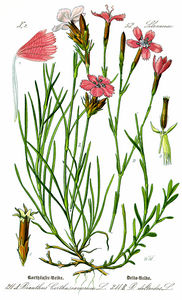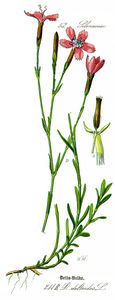User:Andreas Plank/Laminatable plates of plants for environmental education (mountain meadows in the Ore Mountains—plant fan of Mountain Ridge Encounters “Kammbegegnungen”)
| Project in Detail |
| by: Andreas Plank |
| Cooperation with: Natura Miriquidica e.V. |
Summary: Compilation of 42 laminable plant plates (for A4, high-resolution) following the plant fan “From Arnica to Quaking Grass - mountain meadow plants of the Ore Mountains” (Natura Miriquidica e.V. 2013), as well as research and summary of individual plant characteristics. The plant plates are to be 2-sided: Front (unlabelled) plate and back with species names, plant specialities, usage and nature conservation information.
Key words: plant plates, determination, environmental education, grassland plants, Ore Mountains
Open issues:
- processing of high-quality old plant plates from book scans of old plant plates (see http://biodiversitylibrary.org, http://commons.wikimedia.org, http://plantillustrations.org)
- color corrections of old scans where necessary
- compilation of plant characteristics from e.g. Düll & Kutzelnigg (1994), Dietrich (2000), http://floraweb.de and others
- generate a PDF and publish it on the Biowikifarm
Help & sustain: Please support the project financially for the completion of the 42 high resolution plant plates of mountain meadow plants of the Ore Mountains for work in the field of nature conservation, including research of plant characteristics, usage and nature conservation information. Estimated working time 6-9 months, 6000–9000 € & material costs ≈ 50-100 €.
Direct support (PayPal.me), achieved so far: 2000 + 368,22 € ![]()
Inhaltsverzeichnis
Project Details
The plant fan “From Arnica to Quaking Grass - Mountain Meadow Plants of the Ore Mountains” (Natura Miriquidica e.V. 2013) comprises 42 mountain meadow plants, but there are only a few high quality colour plates of the plants, which can also be printed in high resolution on A4. From old books there are high-quality colour plates (Sturm & Sturm 1796; Thomé & Müller 1885ff.; Köhler & Müller 1887; Köhler & Müller 1890; Fuchs et al. 1542), which have yet yellowed backgrounds and often have not yet been devised in high resolution. Often there are inferior, unfavorably color-corrected picture plates or they are available only in lower resolution on Wikimedia Commons for example.
These 42 coloured plant plates should be made publicly accessible, with the background that they can be used for environmental education, e.g:
- as a determination game, guess of determination (the picture plate is always without species name)
- for assigning collected plants
- to compare similar plants, possibilities of confusion
- as a memory game with the task e.g. to look at 5 plant plates for 30 seconds, in order to then find these plants on the meadow from of memory only
- helpful in finding and preparing wild herb mixtures for the wild kitchen etc.
Typical Progress of Work of the Image Processing
Example Plant Plate Arnica montana. L.—Arnica
Here an example for a compact representation of the plant information for the picture board of the protected Arnica
Work Status: List of Processed Plates
| The German Plant Name | Scientific Plant Name | on page | Bearbeitungsstand (Bild) |
Processing Status (Plate) |
|---|---|---|---|---|
| Arnika | Arnica montana L. | 6 | finished | finished |
| Acker-Knautie | Knautia arvensis (L.) Coult. | 26 | finished | finished |
| Ährige Teufelskralle | Phyteuma spicatum L. | 5 | finished | finished |
| Alantdistel | Cirsium heterophyllum (L.) Hill | 24 | finished | finished |
| Bärwurz | Meum athamanticum Jacq. | 2 | finished | finished |
| Berg-Hartheu | Hypericum montanum L. | 8 | finished | finished |
| Blutwurz | Potentilla erecta (L.) Raeusch. | 14 | finished | finished |
| Borstgras | Nardus stricta L. | 38 | finished | finished |
| Echter Ehrenpreis | Veronica officinalis L. | 28 | finished | finished |
| Feld-Hainsimse | Luzula campestris (L.) DC. | 31 | finished | finished |
| Frauenmantel | Alchemilla vulgaris L. | 42 | finished | finished |
| Gemeine Schafgarbe | Achillea millefolium L. | 3 | finished | finished |
| Gemeiner Thymian | Thymus pulegioides L. | 20 | finished | finished |
| Gemeines Zittergras | Briza media L. | 34 | finished | finished |
| Gewöhnliche Kreuzblume | Polygala vulgaris L. | 29 | finished | finished |
| Gewöhnliches Ruchgras | Anthoxanthum odoratum L. | 33 | finished | finished |
| Großer Wiesenknopf | Sanguisorba officinalis L. | 23 | finished | finished |
| Heide-Nelke | Dianthus deltoides L. | 15 | finished | finished |
| Heidelbeere | Vaccinium myrtillus L. | 30 | finished | finished |
| Hornklee | Lotus corniculatus L. | 7 | finished | finished |
| Kleiner Klappertopf | Rhinanthus minor L. | 10 | finished | finished |
| Knolliger Hahnenfuß | Ranunculus bulbosus L. | 12 | finished | to do |
| Kuckuckslichtnelke | Silene flos-cuculi (L.) Greuter & Burdet | 16 | finished | to do |
| Margerite | Leucanthemum vulgare Lam. | 4 | finished | fertig |
| Rot-Klee | Trifolium pratense L. | 18 | finished | to do |
| Rot-Schwingel | Festuca rubra L. | 36 | finished | to do |
| Rote Lichtnelke | Silene dioica (L.) Clairv. | 17 | finished | to do |
| Rundblättrige Glockenblume | Campanula rotundifolia L. | 25 | finished | to do |
| Sauerampfer | Rumex acetosa L. | 41 | finished | to do |
| Spitz-Wegerich | Plantago lanceolata L. | 32 | finished | finished |
| Stattliches Knabenkraut | Orchis mascula (L.) L. | 21 | finished | to do |
| Trollblume | Trollius europaeus L. | 13 | finished | to do |
| Tüpfel-Hartheu | Hypericum perforatum L. | 9 | finished | to do |
| Vogel-Wicke | Vicia cracca L. | 27 | finished | finished |
| Wald-Schlüsselblume | Primula elatior (L.) Hill | 11 | finished | fertig |
| Wald-Storchschnabel | Geranium sylvaticum L. | 19 | finished | to do |
| Wiesen-Bärenklau | Heracleum sphondylium L. | 1 | finished | finished |
| Wiesen-Goldhafer | Trisetum flavescens (L.) P. Beauv. | 40 | finished | to do |
| Wiesen-Kammgras | Cynosurus cristatus L. | 35 | finished | finished |
| Wiesen-Knöterich | Bistorta officinalis Delarbre | 22 | finished | to do |
| Wiesen-Rispengras | Poa pratensis L. | 39 | finished | finished |
| Wolliges Honiggras | Holcus lanatus L. | 37 | finished | finished |







